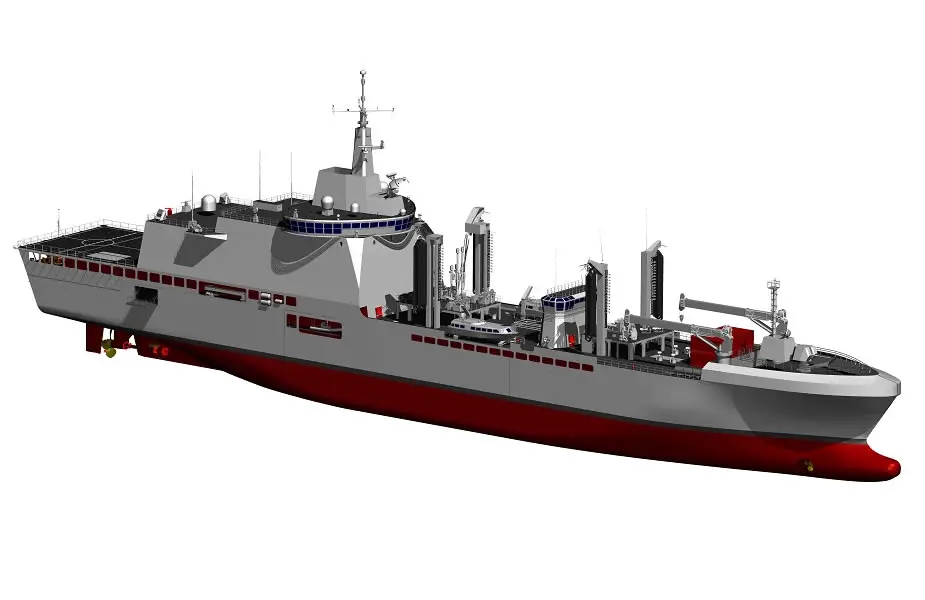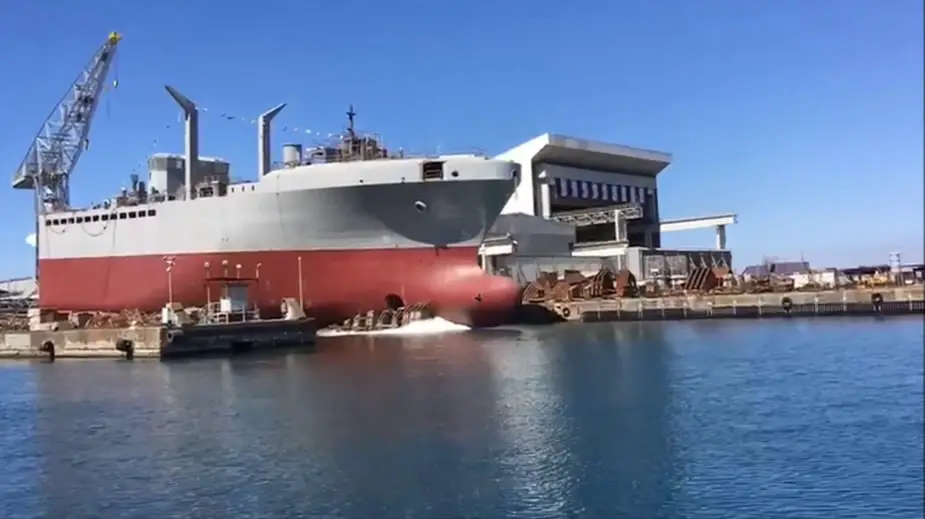Breaking news
Naval Group Fincantieri Merger on Track - French Navy to Get LSS Logistics Vessels.
The merger between Naval Group and Fincantieri, two major naval shipbuilding gourps, appear to be well on track following a high level ministerial meeting held in Rome on February 1st 2018. The first concrete symbol from this merger is likely to be the procurement by France of Vulcano class LSS Logistic Support Ships originally designed for the Italian Navy.
 Computer rendering of LSS Vulcano. Italian Navy image.
Computer rendering of LSS Vulcano. Italian Navy image.
French Minister of the Armed Forces and Minister of Economy and Finance, traveled to Rome on Thursday 1 February 2018 to discuss the project of alliance between Naval Group and Fincantieri with their Italian counterparts and CEOs of both groups. This meeting was an opportunity to recall the determined support of France and Italy to this project of alliance and strengthening of the French-Italian naval industry. This meeting was followed by a meeting of the CEOs of both shipyards and the heads of French and Italian major defense companies Thales and Leonardo in Paris on February 2nd 2018. The ultimate goal is to create a leading European naval defense giant.
According to a French MoD press release, this alliance will allow the construction of a solid industrial and commercial project. between the two groups. This will be achieved through the joint design and construction of surface vessels, of which the logistic support and refueling vessel should be a prime example. This alliance will also enable the two companies to present a united front for military exports on heavily armed surface ships, based on a coordinated product policy and benefiting from international locations complementary of the two companies.
 Bow section of LSS Vulcano was launched in April 2017
Bow section of LSS Vulcano was launched in April 2017
It appears that the three remaining Durance-class replenishment oilers (Var, Marne and Somme) of the French Navy (Marine Nationale) will be replaced with four Vulcano-class LSS. French President Macron announced last month that the "replenishment oilers would be replaced and their number increased". This will likely be formally confirmed in the next French military planning law (Loi de Programmation Militaire). Construction of the first French LSS could start around 2020 at St Nazaire / STX shipyard for a delivery two years later.
Back in September 2017, the French procurement agency awarded a contract to Naval Group to "study the adaptation of the Italian Vulcano design to the French Navy needs". Navy Recognition contacted the French procurement agency DGA (back in Semptember) for further details:
Question: What is the scope of this contract study, what is asked of Naval Group?
DGA: Naval Group and STX France (St-Nazaire) are working in co-contracting on this study, which aims to compare the architecture of the Italian ship with the operational needs of the French navy and the technical reference of the DGA. The challenge is to be able to then determine which parts of the Italian vessel can be left unchanged, and which French specificities will require an adaptation of the Italian design to be taken into account.
Question: Does the DGA continue to work on the BRAVE* design?
DGA: This design corresponds to the architecture resulting from the French preliminary studies, before the cooperation with Italy was envisaged. The DGA no longer works on the basis of this sketch. Nevertheless, some specific parts of this design may be reused, especially in cases where the corresponding parts of the Italian ship do not meet French requirements.
Question: Has the BRAVE design ever been tested in a test tank?
DGA: Numerical calculations and tests with scale models were carried out at DGA Techniques hydrodynamiques: stability, maneuverability, seaworthiness. It is in particular from these studies and tests that the BRAVE design was proposed by Naval Group and STX France.
We also contacted OCCAR, which manages the Italian LSS Programme. An OCCAR representative explained "The LSS Programme was integrated into OCCAR in 2015 with the initial participation of Italy and the potential participation of France. France is currently in the integration process into the Programme. The current industry contract for Italy includes the development and production of one ship and the in-service support for ten years. Its delivery is planned for 2019. When France has joined the programme and the results of ongoing analysis are available, the contract for France will be awarded by OCCAR".
*The BRAVE (Bâtiment RAVitailleur d'Escadre) design was unveiled by DCNS during Euronaval 2010. A significantly updated design was rolled out during Euronaval 2012. And the last time we heard about the BRAVE project was in 2015, with DCNS working on a "full electric" variant".
Basic specifications compared:
Durance-class: Dimensions: 157 m x 21 m | Displacement: ~ 17,900 t | Speed: 19 knots | Crew : ~ 170 +45
BRAVE (baseline 2010): Dimensions: 195 m x 28 m | Displacement: ~ 30,000 t | Speed: > 19 knots | Crew : ~ 100 + 100
BRAVE (full electric 2015): Dimensions: 198 m x 28,5 m | Displacement: ~ 33,000 t | Speed: > 20 knots | Crew : ~ 125 + 100
LSS Vulcano: Dimensions: 179 m x 24 m | Displacement: ~ 25,000 t | Speed: > 20 knots | Crew : ~ 200 (total)
Our short video on LSS at Euronaval 2016
Vessel’s characteristics - LSS – Logistic Support Ship
The LSS is a vessel that provides logistics support to the fleet, endowed with hospital and healthcare capabilities thanks to the presence of a fully equipped hospital, complete with operating rooms, radiology and analysis rooms, a dentist’s office and hospital rooms capable of hosting up to 12 seriously injured patients. The ship is capable of combining capacity to transport and transfer to other transport vessels used for liquids (diesel fuel, jet fuel, fresh water) and solids (emergency spare parts, food and ammunitions) and to perform at sea repairs and maintenance work for other vessels. The defense systems are limited to the capacity of command and control in tactical scenarios, communications and dissuasive, non-lethal defense systems. The vessel is also capable of embarking more complex defence systems and becoming an intelligence and electronic war platform.
• 179 meters long
• speed of 20 knots
• 200 persons including crew and specialists
• 4 replenishment station abeam and 1 astern
• Capacity to supply drinking water to land
• Capacity to provide electricity to land with 2500 kw of power
• Possibility of embarking up to 8 residential and healthcare modules
• Capacity to perform rescues at sea, through recovery and seabed operations (the ship is equipped with an 30 tons offshore stabilized crane stabilized)
• base for rescue operations through helicopters and special vessels
Fincantieri launched the bow section of "Vulcano" in April last year. Its construction in ongoing. The stern section is being built at the Riva Trigoso Naval Shipyard and the bow section was built at the Castellammare di Stabia (Naples) Naval Shipyard. A5335 Vulcano is set to enter in service with the Italian Navy (Marina Militare) in 2019 to replace Stromboli (A5327) and Vesuvio (A5329) AORs.

Full tanscript/translation of the French MoD press release:
Proposed merger between Naval Group and Fincantieri
Florence Parly, Minister of the Armed Forces, and Bruno Le Maire, Minister of Economy and Finance, traveled to Rome on Thursday 1 February 2018 to discuss the alliance project between Naval Group and Fincantieri with their Italian counterparts and CEOs of both groups. This meeting was an opportunity to recall the determined support of France and Italy to this alliance and to the strengthening of the French-Italian naval industry project.
Ministers were able to note the progress made on the project since the announcements made by the President of the French Republic and the Italian Prime Minister at the Lyon Summit in September 2017. This alliance will allow the construction of a solid industrial and commercial project. between the two groups. This will be achieved through the joint design and construction of surface vessels, of which the logistic support and refueling vessel should be a prime example. This alliance will also enable the two companies to present a united front for military exports on heavily armed surface ships, based on a coordinated product policy and benefiting from international locations complementary of the two companies.
This merger will also allow the two companies to pool their research and development efforts, and thus to be at the forefront of key innovations for the naval sector: the optimization of energy consumption, the electrical architecture of vessels or even Li-Ion batteries or mastering complex architectures for example.
The alliance of the two groups will finally allow synergies and the sharing of best practices in purchasing, services and industrial methods, of which first illustrations were shared.
This project aims to significantly strengthen the industrial bases of technology and naval defense in France as in Italy, bringing economic, industrial and social reinforcement, and an increased international influence of the naval industry of the two States. It will thus help to develop employment and support the balance of trade both in France and in Italy.
Work between industry groups will continue in joint working groups over the coming months. The details of the proposed alliance will be presented to both governments in June 2018.
At the same time, the French and Italian governments will work on the same timetable to draft an intergovernmental agreement that will serve as a framework for this alliance, preserve their vital interests while making the exchanges between the two groups more fluid.


























